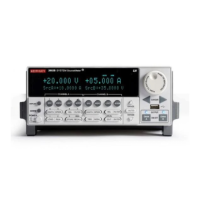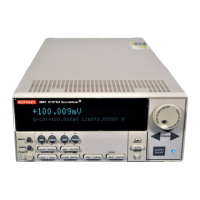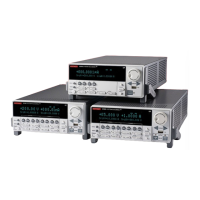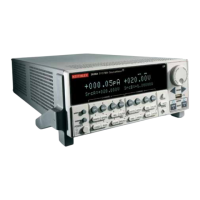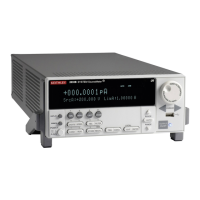System SourceMeter® Instrument Reference Manual Section 3:
2600BS-901-01 Rev. C / August 2016 3-77
Both the display.inputvalue() and display.prompt() functions display the editable input
field, but the display.inputvalue() function does not include the text strings for units and
help.
After one of the above functions is executed, command execution will pause and wait for the operator
in input the source level. The program will continue after the operator enters the value by pressing the
navigation wheel
or the ENTER key.
The following programming example illustrates how to prompt the operator to enter a source voltage
value for SMU A:
display.clear()
value = display.prompt("0.00", "V", "Enter source voltage")
display.screen = display.SMUA
smua.source.levelv = value
The script pauses after displaying the prompt message and waits for the operator to enter the voltage
level. The display then toggles to the source-measure display for SMU A and sets the source level to
value.
If the operator presses EXIT(LOCAL) instead of entering a source value, value will be set to nil.
The second line of the above code can be replaced using the other input field function:
value = display.inputvalue("0.00")
The only difference is that the display prompt will not include the “V” units designator and the “Enter
source value” message.
Indicators
To determine which display indicators are turned on, use the display.getannunciators()
function. For example, to determine which display indicators are turned on, send the following
commands.
annun = display.getannunciators()
print(annun)
The 16-bit binary equivalent of the returned value is a bitmap. Each bit corresponds to an indicator. If
the bit is set to “1”, the indicator is turned on. If the bit is set to “0”, the indicator is turned off.
The following table identifies the bit position for each indicator. The table also includes the weighted
value of each bit. The returned value is the sum of all the weighted values for the bits that are set.
For example, assume the returned bitmap value is 34061. The binary equivalent of this value is as
follows:
1000010100001101
For the above binary number, the following bits are set to “1”: 16, 11, 9, 4, 3 and 1. Using the table,
the following indicators are on: REL, REM, EDIT, AUTO, 4W and FILT.
